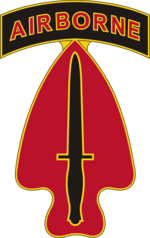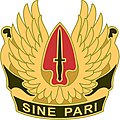US Army Special Operations Command
| United States Army Special Operations Command (Airborne) | |
|---|---|

Distinctive unit insignia of USASOC Headquarters
|
|
| Founded | 1 December 1989 |
| Country |
|
| Branch |
|
| Type | Special warfare operations |
| Role | Organize, train, educate, man, equip, fund, administer, mobilize, deploy and sustain U.S. Army special operations forces to successfully conduct worldwide special warfare operations. |
| Size |
33,805 personnel authorized:
|
| Part of |
|
| Headquarters | Fort Bragg, North Carolina, U.S. |
| Motto(s) | "Sine Pari" (Without Equal) |
| Engagements |
Invasion of Panama |
| Website | Official Website |
| Commanders | |
| Notable commanders |
LTG Kenneth E. Tovo Robert W. Wagner Edward M. Reeder Jr. John F. Mulholland, Jr. Charles T. Cleveland |
| Insignia | |
| Combat service identification badge (CSIB) of the command, MISGs units, and 1st SFOD-D | |
| Beret flash of the command | |
| Former distinctive unit insignia of the command (1990-2011) | |
33,805 personnel authorized:
Invasion of Panama
Persian Gulf War
Unified Task Force
Operation Gothic Serpent
Operation Uphold Democracy
War on Terror
The United States Army Special Operations Command (Airborne) (USASOC) is the command charged with overseeing the various special operations forces of the United States Army. Headquartered at Fort Bragg, NC, it is the largest component of the United States Special Operations Command. Its mission is to organize, train, educate, man, equip, fund, administer, mobilize, deploy and sustain Army special operations forces to successfully conduct worldwide special operations.
Established in 1952, the U.S. Army Special Forces Command (Airborne), also known as the Green Berets, was established as a special operations force of the United States Army tasked with five primary missions: unconventional warfare, foreign internal defense, special reconnaissance, direct action, and counter-terrorism. These missions make special forces unique in the U.S. military, because they are employed throughout the three stages of the operational continuum: peacetime, conflict and war.
Today's Special Forces Groups and their unconventional warfare capabilities provide a viable military option for a variety of operational taskings that are inappropriate or infeasible for conventional forces, making it the U.S. military’s premier unconventional warfare force.
...
Wikipedia



